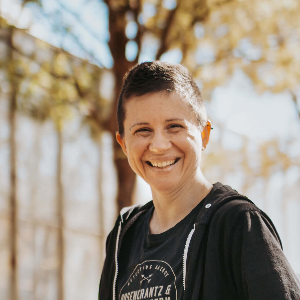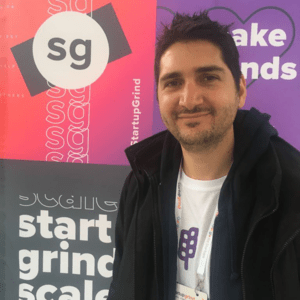I’m a computer engineer transformed into a ⚙️ passionate No Coder ⚙️. Reach out if you want to get introduced or learn more about the No Code world!
It’s not so complicated: Startup home pages
Here is a paradox about startup home pages
The hero section is confusing and not informative (no surprises here)
But if you go to the last third of your home page, in many cases you can find resonating messages
Here is a “hack” by Sam Howard
Grab them and move them to the hero section to hopefully see bounce rates go down, and time on page go up
In this episode, you’ll hear about:
- a conversion-copywriter’s point of view about startup home pages
- what makes a good startup home page
- 3.5 steps to develop your home page
- how customer research is involved
- the 7 Sweeps of Copy Editing
Tools mentioned:
And all these in less than 12 min.
Transcript
Ekaterina (Sam) Howard: Hi. I’m Ekaterina Howard. I also go by Sam. I am a conversion copywriter working with B2B SaaS startups that are ready to grow.
Spyros Tsoukalas: Sam, welcome to the Growth Mentor podcast, I’m excited to discuss with you about a topic that I have personally suffered from in the past startup home pages. So tell us something we don’t know about startup home pages, I am excited to learn something new here.
Ekaterina (Sam) Howard: Alright, so this is the closest I’m ever going to get to a hack. Like, I’m not promising you that you will be able to 10x your conversions with this thing. But what I have noticed happen on multiple startup home pages is that the hero section is super bland, not informative doesn’t help me understand what’s going on. No surprises here, to go to the last third of your home page and see if you can find resonating messages there. In most cases, you can, then you just need to grab them, move them to the hero section. And hopefully see bounce rates go down and time on page go up.
Spyros Tsoukalas: Okay, that’s interesting. It’s like people know what to do, but they put it in the wrong place.
Ekaterina (Sam) Howard: Yes.
Spyros Tsoukalas: So based on your work and experiences, could you mention a few more things that you see startups doing wrong when dealing with their home pages? Obviously, your example, your hint was one is one of them. But like, I guess you have more ideas around that?
Ekaterina (Sam) Howard: Yes. So I mean, to be clear, this is a conversion copywriter point of view. So I’m sure that other like product marketers will have their own approach. But for me, the biggest things that go wrong and home pages is kind of throwing it together without having a narrative structure, following competitors, especially if it’s like aspirational following competitors, when you look at Trello home page, and you want one just like that, except everybody knows what Trello is. And not many people know what your startup does. And I would say, copying competitors, just because it seems like the thing to do, as opposed to kind of building out the structure that explains how you’re different and why it matters to your prospects.
Spyros Tsoukalas: So trying to combine your value proposition, but at the same time copying more successful competitors ends up in a mess.
Ekaterina (Sam) Howard: More often than not, it does, just because you’re at different stages of growth. So what works for them is not necessarily going to work for you.
Spyros Tsoukalas: And given let’s say all these, I guess that influences how new users are acquired. Why is that so hard?
Ekaterina (Sam) Howard: So many reasons. Like specifically for home pages. I know it’s like super enticing to just like drop the CTA and be like here, sign up book a demo. But are they ready? And if it’s a landing page, then most likely yes, you can convince them to hit the button. If it’s not, then you need to work harder to convince them to, like, give you their time or consider your product. And I think that figuring out why will the new users even care to sign up is the most important thing here.
Spyros Tsoukalas: So we have been looking at the mistakes side of home page. But what does what makes a good home page? Like what would you look for?
Ekaterina (Sam) Howard: So many things. The most important one is probably does it make sense? Right? So if it’s just like sections stacked together, then it doesn’t help me understand why I should keep clicking through. The second one is, like if it makes sense, if there is a messaging hierarchy. The second question is, does it help me as a prospect, figure out what to do next, and where to go for additional information. So for example, if you have to target audiences to ICPs you’re trying to talk to, this is where you need to help them kind of go to the ICP a specific page so they can figure out how your product helps them specifically. And then finally, being very clear on what the ultimate goal is, like, if all you want from all of your users is to jump on the demo, then I should be able to tell this is the case, from like from the hero section of your home page. So I know like what the ultimate thing I need to do is.
Spyros Tsoukalas: Okay, so if I were a newbie, and I am a newbie, let’s say and I want to develop my startups home page. So could we list the steps of things that I should be doing or caring about, like a few steps. So.
Ekaterina (Sam) Howard: Yes. So, the unpleasant answer would be, it depends on the stage. A more specific answer would be in an ideal world, everybody starts with research and knows who they’re talking to what the pain points are, and what the desirable outcome is. So that’s the research part. The next step is organising this into an on page messaging hierarchy. So you know where to start in the hero section. And you know, like, what to say next, instead of randomly throwing features on the page and hoping it works out. And after that, the next step would be a adding the copy, and then be having a plan for validating it and making it better as you learn more about the way your website visitors interact with it.
Spyros Tsoukalas: I think that the first step is, I mean, what I have made as a mistake in the past, and I think we’re most let’s say, people that haven’t still failed with it, fail. So how do you execute that? Like, how is customer research involved in the process of developing your home page and all the next steps that you mentioned?
Ekaterina (Sam) Howard: So we could talk about this for hours, because I am a huge fan of customer research as a way to get more conversions, but on a very like, and I know it feels intimidating, because there’s so much that you could be doing. So the MVP version would be get feedback on your home page draft. So doesn’t have to be like 20 plus users. But if you can just do a messaging test, see what resonates what doesn’t, then move forward. If you are more ambitious than talk to your customers, figure out what they care about. And use that to inform your home page copy decisions.
Spyros Tsoukalas: Do you use any specific framework with when dealing with customers? I’m a big fan of jobs to be done. But I’m curious to learn more frameworks around this.
Ekaterina (Sam) Howard: I love jobs to be done. They make it so much easier to figure out like what to lead with. But sometimes depending on the market, you might be better off with problem agitation solution. So it depends on like how well aware your audience is of the problem you’re trying to solve and just how painful it is. Like if it’s extremely painful, just just stay with that.
Spyros Tsoukalas: I’m very interested. Like, the bigger the pain, the more probable the success, let’s say of what you’re trying to do if you formulate it in a good way. But that’s another topic. I like to focus on the copywriting part, since it’s your expertise of that process that you described. So how do you like you’re a professional in the field, but like, how do you deal with copy? I mean, meaning be not being a native speaker. That’s the toughest part of all.
Ekaterina (Sam) Howard: So let’s break this down a bit. I am very aware of the whole native speaker versus non native speaker narrative. And as a just don’t worry about it, you can find an editor to clean this up. Like this is not a problem. The problem is, what do I say? And how do I say? So what do I say is why we do research? So we don’t have to guess like what do they care about? We know this. And how do I say it is the part where ideally you combine voice of customer research, because there is a specific way that your prospects talk about their problems and desires. And if you use those words, they feel warm and fuzzy, and they know you get them and they’re much more interested in reading on and just copywriting best practices. Right. I am a huge fan of using the 7 Sweeps from Copy Hackers. So is it clear? Is it specific? Are there any emotional triggers that help the copy resonate? And is the copy believable? Plus three more.
Spyros Tsoukalas: Okay, this gives me confidence that lists to try again with copy or continue trying instead of like expecting to receive a masterclass and then be the best copywriter in the world. So thanks for at least inspiring me to go that direction. So last part of today’s discussion, are there any favourite tools around the topic that you use or you would recommend to startups?
Ekaterina (Sam) Howard: Yes, I actually have two that I bring up during every call pretty much. One is Hotjar. Because if you don’t know what’s happening on your website, like how can you even fix it? And Google Analytics doesn’t provide enough at least for me to really figure out what’s not working on a specific page. And then Wynter. Wynter is not free, to put it mildly. But when you don’t have time to do customer research, or when you just cannot get your customers to talk to you. Wynter messaging panels solve this by giving you ICP specific feedback on a specific page. So you can make specific changes without kind of flailing around and trying to guess what’s broken.
Spyros Tsoukalas: Sam, thank you very much for sharing your experiences with us today. To be honest, I didn’t expect to learn so much from this conversation, but like you surprise me with all thei very specific hints and steps and processes that you explained, because I expect it to be a little more broad conversation, but like you nailed it. Thank you very much for sharing all these insights, and I hope the audience will enjoy it as much as I did.
Ekaterina (Sam) Howard: Thank you for having me.
Spyros Tsoukalas: You’re very welcome.
In this episode


I help B2B SaaS startup founders and growth marketers get more traction with research-driven conversion copy — without slowing down their growth initiatives
Join the community
Enjoy the peace of mind that advice is always only one Zoom call away.


